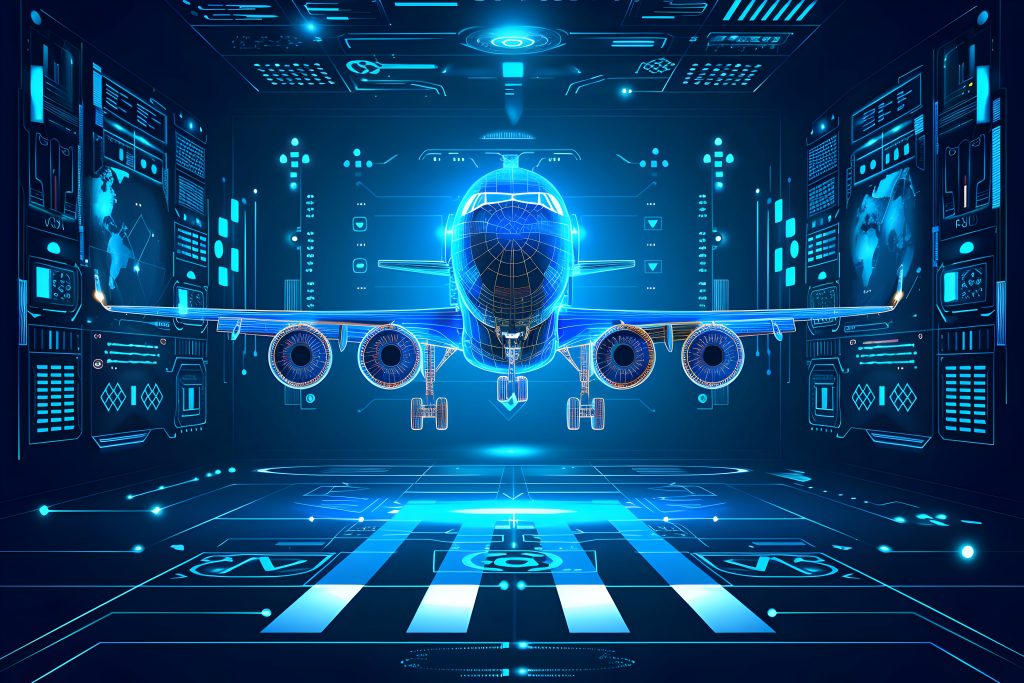In today’s rapidly evolving technological landscape, Artificial Intelligence (AI) stands as a cornerstone of innovation reshaping and redefining the way we interact with the world around us. It plays a pivotal role in society today transforming industries across the globe. As AI continues to evolve, its impact on society is poised to grow, ushering in a future marked by unprecedented advancements in technology and human-machine collaboration.
AI’s Integral Role in the Evolution of Aviation
While AI is already utilized in diverse applications within the aviation industry such as autonomous navigation systems or predictive maintenance algorithms for aircraft engines, its adoption and integration continues to expand and diversify. AI does not only revolutionize the way airplanes fly but also exerts its transformative influence across all facets of aviation operations on the ground.
There is an increased interest in AI which can be primarily due to the expected continuing rise in passenger numbers. IATA’s Gobal Outlook for Air Transport, a comprehensive overview of the developments in the aviation industry, states that global passenger traffic are expected to double by 2040.
Transforming the Passenger Experience
AI is transforming different facets of the aviation industry, from flight operations to customer service. These are some ways in which AI technology is redefining the passenger experience:
Facial Recognition and Biometrics: The check-in process and security are being streamlined through the accurate identification of passengers via facial recognition and biometric data.
Baggage Handling Process: The handling of baggage is being optimized through AI-powered systems that track and manage luggage, reducing the likelihood of lost or mishandled bags.
Assistance and Chatbots: Seamless assistance is being provided to passengers throughout their journey by AI chatbots, including AI-powered translation services for overcoming language barriers.
Conversational Assistance: Natural language-interaction systems are being developed, allowing passengers to interact with AI assistants conversationally, making inquiries and receiving assistance in a user-friendly manner.
Predictive Analytics for Flight Delays: Predictive analytics are being utilized to forecast potential flight delays, enabling adjustments to be made by passengers, airports, and airlines to minimize disruptions to travel schedules.
These are just a few examples of key areas in which the passenger experience can transform the passenger experience.
AI Safeguarding Self-Service Solutions
As a software service provider in the aviation industry, integrating artificial intelligence (AI) can profoundly enhance safety measures in several crucial areas. Some examples are:
Cybersecurity: AI can be utilized to detect and prevent cyber threats, such as malware and phishing attacks, by analyzing network traffic and identifying abnormal patterns.
Behavioral Analysis: Real-time analysis of security footage can be conducted by AI algorithms, enabling the detection of suspicious behaviors. This assists security personnel in identifying potential threats before they escalate.
Anomaly Detection: Unusual or hidden patterns in data that deviate from the norm can be identified through AI-based anomaly detection methods.
Predictive Analytics: By analyzing vast amounts of data, potential security risks and threats can be predicted by AI, allowing authorities to take proactive measures to prevent incidents.
Optimizing Efficiency of Self-Service Solutions in the Aviation Industry
Not only can AI optimize passenger handling processes, but it also revolutionizes operational efficiency and maintenance procedures.
Intelligent Workload Distribution: AI algorithms can optimize workload distribution across distributed computing environments, such as cloud-based infrastructures. By intelligently routing tasks to the most suitable resources, AI enhances scalability by ensuring efficient utilization of available resources while maintaining flexibility to accommodate changing workloads due to for example varying passenger traffic.
Predictive Scaling: AI algorithms can analyze historical data on user traffic, system performance, and resource utilization to predict future demand. By accurately forecasting workload patterns, AI enables proactive scaling of software services, ensuring that resources are dynamically allocated to meet anticipated demand, thus enhancing scalability.
Predictive maintenance: Self-service hardware and software components are monitored in real-time by AI-powered predictive maintenance systems, which detect potential issues before they escalate into service disruptions. By proactively addressing maintenance needs, downtime is minimized, and continuous availability of self-service facilities is ensured.
Performance monitoring and optimization: The performance of self-service systems is continuously monitored by AI-driven analytics, which identify bottlenecks, inefficiencies, and areas for improvement. This enables data-driven decisions by operators to optimize processes, enhance user experience, and maximize service efficiency.
The Human Factor in the Future of AI
While the rapid and continuous development of AI leads many people to fear that AI will take over all jobs, the reality is different. Instead, a human-centric approach to AI involves leveraging artificial intelligence to complement and augment human capabilities rather than replacing them entirely. With advancements in machine learning, predictive analytics, and autonomous systems, AI will continue to redefine the way we approach air travel. From optimizing flight operations and enhancing safety protocols to revolutionizing passenger experiences, AI holds the key to unlocking new levels of efficiency, reliability, and convenience in aviation. As these technological advancements are embraced, smarter, safer, and more sustainable skies can be expected in the years to come.



